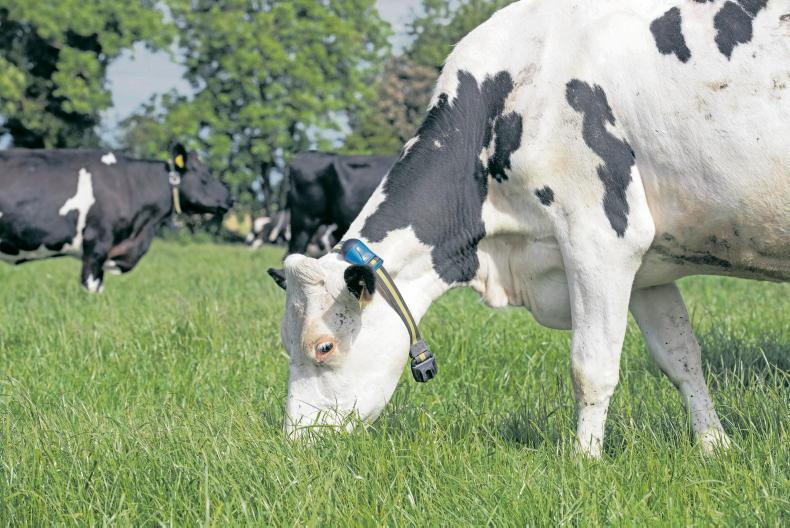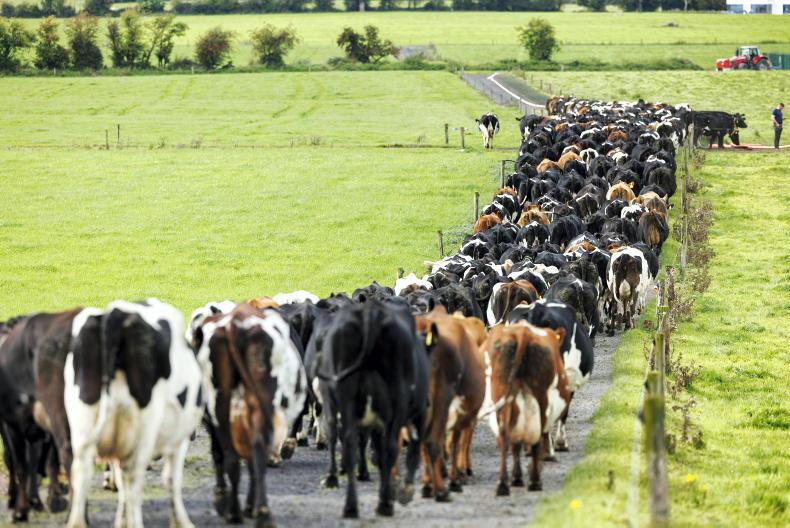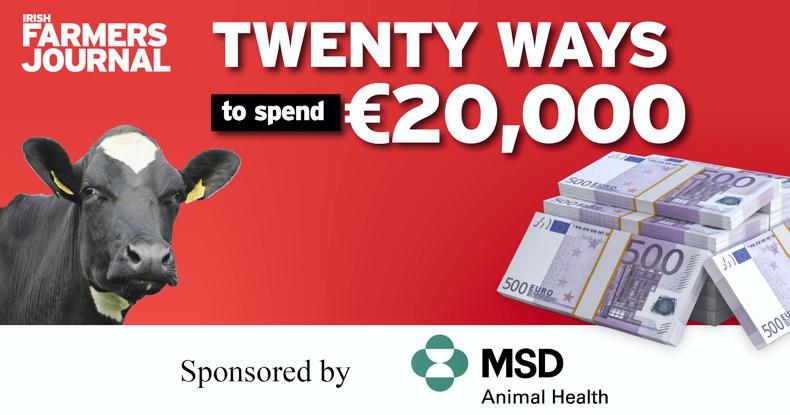Investment in technology is on the rise. Heat detection aids like collars and boluses can offer a labour-saving opportunity for farmers over the course of the busy breeding season.
These automated heat detection aids work by monitoring different markers like cows’ activity levels, rumination and temperature changes.
While identifying cows in heat, most detection aids can also help to identify cows on the point of calving and sick animals before they become clinical cases.
This is done through 24-hour monitoring for spikes in the different metrics used in the algorithm.
They have proven themselves as useful tools in terms of cutting labour requirements. They typically need to work in co-ordination with an automatic drafting system to maximise the benefits. We will be covering drafting gates later in the series.
Conception rates
Although they’re a nice tool to have there’s no concrete evidence out there to support claims these heat detection aids improve conception rates or lower empty rates. They will, if the farmer is poor at detecting heats in cows, or if there’s an issue with time available to observe cows.
If a farmer is very good at what they do, collars or boluses aren’t going to revolutionise the farm in terms of financial return. Most farmers are happy with the health alerts provided, but again there’s no evidence to support them reducing vet costs or cases of illness. Outside of saving labour, the benefits will be minimal once good practice is already being applied.
Many farmers have already made the jump and heat detection aids have gained traction in the last four to five years. It seems to be an investment of interest to farmers at the moment so we will look to identify some of the costs involved.
Collars
Collars are the most common type of heat detection aid seen on Irish farms. They are worn by cows around the neck and pick up the different markers of activity.
They then correspond to a base station which is usually located around the collecting yard or parlour, an area where cows are passing daily. This information is fed back to the farmers' laptop or phone and allows them to make timely decisions.
A base station will cost approximately €3,700 for one unit including VAT @23%
Collars have a battery life of five to seven years and will need to be replaced after this point. For the sake of this article, we will be only looking at costs involved in the initial investment and the annual upkeep costs for a herd of 100 cows.
The first step is purchasing a base station, and the 100 collars. A base station will cost approximately €3,700 for one unit including VAT @23%. The collars typically cost around €166/cow including VAT, but each manufacturer has different prices.
In a 100-cow herd, you’re looking at an investment in the region of €20,300 upfront. A TAMS grant is available on collars up to 120 cows. If we consider a TAMS grant of 40% on the reference cost of €112.25 per unit and €2,833 for the base station the total amount that can be claimed back on the €20,300 investment is €5,623.
This means that the total cost will be €14,677 including VAT for 100 cows based on the guideline prices. The collars last five to seven years so if we take it as five, the cost spread over five years gives you a cost of €2,935 per year.

Automated heat detection aids have been shown to reduce labour input during the breeding season.
Some manufacturers, such as MSD Sensehub also offer a €3.50/cow/month subscription service including VAT, which takes the burden of the initial investment off. However, this will work out slightly more expensive over the upfront investment and TAMS III is not available on this option.
Tail paint
Tail paint in comparison is available at a rough costing of €12/bottle. We’ll assume a 12-week AI breeding season. Over 12 weeks, 40 bottles of tail paint will cost you €480.
Labour involved in observing cows daily is the primary cost saving of concern. We are estimating 1.5 hours/day spent observing cows during the breeding season, the time recommended by Teagasc, at a cost of €20/hour. Over the 12-week breeding season that’s a cost of €2,520. Including the cost of tail paint at €480, collars will save the farm roughly €3,000 per year.

Traditional tailpainting relies on operator skill to interpret a bulling cow.
A figure of €3,000 divided by the overall investment cost of €14,677 (incl. TAMS) gives a figure of 20%. In other words, it would take five years for the collars to pay for themselves, at which point some of the collars will probably need to be replaced.
Boluses
Boluses, like collars work by measuring inner body temperature, water intake, rumination and activity levels. The boluses are administered once and require no further maintenance.
Similarly to collars, the cow passes the base station and the information automatically uploads to an app on your phone or computer.
In most cases, the boluses are guaranteed for the cow’s life. So, if a battery dies, the bolus is replaced for free. However, if cows are culled, the bolus cannot be recovered, so new boluses must be purchased for the heifers entering the herd. With collars, the cull cows’ collar can be transferred to the in-calf heifers.
Base station
A recent Irish Farmers Journal article on a prominent bolus company found that the initial investment requires a base station at a cost of €6,150 including VAT. There's a training fee of €984 and the individual bolus purchase at €43/cow or €4,300. All prices given are including VAT @23% and based on a 100-cow herd. The initial upfront cost is €11,434 for the boluses.
You must also consider the monthly subscription cost that comes with the software in the bolus and the cost for replacing 20% of the herd per year.

There has been a big increase in the amount of farmers investing in technology. \ Donal O'Leary
The yearly subscription is just over €3/cow/month. It works out at €3,700 across the herd and the 20% replacement cost is €860 or €43/bolus. Giving a total yearly fee of €4,560 including VAT.
The total cost over six years is €38,794. Deducting the maximum that can be claimed under TAMS of €5,623 this reduces the cost of €33,171 including VAT.
When we divide this into €3,000 (the cost of tail paint and labour for the year), we see that it will take 11 years to pay for itself.
My rating
There are several different options when it comes to automatic heat detection. As an investment idea, I’m giving this a rating of 3/5.
There isn’t the same quick return when compared with the likes of improving grazing infrastructure, reseeding or genetic improvement. However, as a labour-saving tool that can offer a farmer time away from the farm business, it is always something to consider.
Overall, the boluses workout more expensive but not by a significant amount when it’s costed over a longer period, say 20-year period, as the farmer is continuously investing in the technology.
• SenseHub Dairy Behaviour Monitoring is part of the SenseHub Ecosystem and is designed with the farmer in mind. The Ecosystem also includes SenseHub Inline SCC Sensor, SenseHub Inline MilkPlus Sensor, SenseHub Drafting Gate and SenseHub Youngstock. All of the technologies connect back to the one location - the SenseHub App. This enables a more connected farm and empowers farmers with more insights than ever before.
• SenseHub has a local dedicated team of 14 personnel supporting customers through On Farm Sales Team and Technical and Customer Success Team.
Investment in technology is on the rise. Heat detection aids like collars and boluses can offer a labour-saving opportunity for farmers over the course of the busy breeding season.
These automated heat detection aids work by monitoring different markers like cows’ activity levels, rumination and temperature changes.
While identifying cows in heat, most detection aids can also help to identify cows on the point of calving and sick animals before they become clinical cases.
This is done through 24-hour monitoring for spikes in the different metrics used in the algorithm.
They have proven themselves as useful tools in terms of cutting labour requirements. They typically need to work in co-ordination with an automatic drafting system to maximise the benefits. We will be covering drafting gates later in the series.
Conception rates
Although they’re a nice tool to have there’s no concrete evidence out there to support claims these heat detection aids improve conception rates or lower empty rates. They will, if the farmer is poor at detecting heats in cows, or if there’s an issue with time available to observe cows.
If a farmer is very good at what they do, collars or boluses aren’t going to revolutionise the farm in terms of financial return. Most farmers are happy with the health alerts provided, but again there’s no evidence to support them reducing vet costs or cases of illness. Outside of saving labour, the benefits will be minimal once good practice is already being applied.
Many farmers have already made the jump and heat detection aids have gained traction in the last four to five years. It seems to be an investment of interest to farmers at the moment so we will look to identify some of the costs involved.
Collars
Collars are the most common type of heat detection aid seen on Irish farms. They are worn by cows around the neck and pick up the different markers of activity.
They then correspond to a base station which is usually located around the collecting yard or parlour, an area where cows are passing daily. This information is fed back to the farmers' laptop or phone and allows them to make timely decisions.
A base station will cost approximately €3,700 for one unit including VAT @23%
Collars have a battery life of five to seven years and will need to be replaced after this point. For the sake of this article, we will be only looking at costs involved in the initial investment and the annual upkeep costs for a herd of 100 cows.
The first step is purchasing a base station, and the 100 collars. A base station will cost approximately €3,700 for one unit including VAT @23%. The collars typically cost around €166/cow including VAT, but each manufacturer has different prices.
In a 100-cow herd, you’re looking at an investment in the region of €20,300 upfront. A TAMS grant is available on collars up to 120 cows. If we consider a TAMS grant of 40% on the reference cost of €112.25 per unit and €2,833 for the base station the total amount that can be claimed back on the €20,300 investment is €5,623.
This means that the total cost will be €14,677 including VAT for 100 cows based on the guideline prices. The collars last five to seven years so if we take it as five, the cost spread over five years gives you a cost of €2,935 per year.

Automated heat detection aids have been shown to reduce labour input during the breeding season.
Some manufacturers, such as MSD Sensehub also offer a €3.50/cow/month subscription service including VAT, which takes the burden of the initial investment off. However, this will work out slightly more expensive over the upfront investment and TAMS III is not available on this option.
Tail paint
Tail paint in comparison is available at a rough costing of €12/bottle. We’ll assume a 12-week AI breeding season. Over 12 weeks, 40 bottles of tail paint will cost you €480.
Labour involved in observing cows daily is the primary cost saving of concern. We are estimating 1.5 hours/day spent observing cows during the breeding season, the time recommended by Teagasc, at a cost of €20/hour. Over the 12-week breeding season that’s a cost of €2,520. Including the cost of tail paint at €480, collars will save the farm roughly €3,000 per year.

Traditional tailpainting relies on operator skill to interpret a bulling cow.
A figure of €3,000 divided by the overall investment cost of €14,677 (incl. TAMS) gives a figure of 20%. In other words, it would take five years for the collars to pay for themselves, at which point some of the collars will probably need to be replaced.
Boluses
Boluses, like collars work by measuring inner body temperature, water intake, rumination and activity levels. The boluses are administered once and require no further maintenance.
Similarly to collars, the cow passes the base station and the information automatically uploads to an app on your phone or computer.
In most cases, the boluses are guaranteed for the cow’s life. So, if a battery dies, the bolus is replaced for free. However, if cows are culled, the bolus cannot be recovered, so new boluses must be purchased for the heifers entering the herd. With collars, the cull cows’ collar can be transferred to the in-calf heifers.
Base station
A recent Irish Farmers Journal article on a prominent bolus company found that the initial investment requires a base station at a cost of €6,150 including VAT. There's a training fee of €984 and the individual bolus purchase at €43/cow or €4,300. All prices given are including VAT @23% and based on a 100-cow herd. The initial upfront cost is €11,434 for the boluses.
You must also consider the monthly subscription cost that comes with the software in the bolus and the cost for replacing 20% of the herd per year.

There has been a big increase in the amount of farmers investing in technology. \ Donal O'Leary
The yearly subscription is just over €3/cow/month. It works out at €3,700 across the herd and the 20% replacement cost is €860 or €43/bolus. Giving a total yearly fee of €4,560 including VAT.
The total cost over six years is €38,794. Deducting the maximum that can be claimed under TAMS of €5,623 this reduces the cost of €33,171 including VAT.
When we divide this into €3,000 (the cost of tail paint and labour for the year), we see that it will take 11 years to pay for itself.
My rating
There are several different options when it comes to automatic heat detection. As an investment idea, I’m giving this a rating of 3/5.
There isn’t the same quick return when compared with the likes of improving grazing infrastructure, reseeding or genetic improvement. However, as a labour-saving tool that can offer a farmer time away from the farm business, it is always something to consider.
Overall, the boluses workout more expensive but not by a significant amount when it’s costed over a longer period, say 20-year period, as the farmer is continuously investing in the technology.
• SenseHub Dairy Behaviour Monitoring is part of the SenseHub Ecosystem and is designed with the farmer in mind. The Ecosystem also includes SenseHub Inline SCC Sensor, SenseHub Inline MilkPlus Sensor, SenseHub Drafting Gate and SenseHub Youngstock. All of the technologies connect back to the one location - the SenseHub App. This enables a more connected farm and empowers farmers with more insights than ever before.
• SenseHub has a local dedicated team of 14 personnel supporting customers through On Farm Sales Team and Technical and Customer Success Team.









 This is a subscriber-only article
This is a subscriber-only article










SHARING OPTIONS: